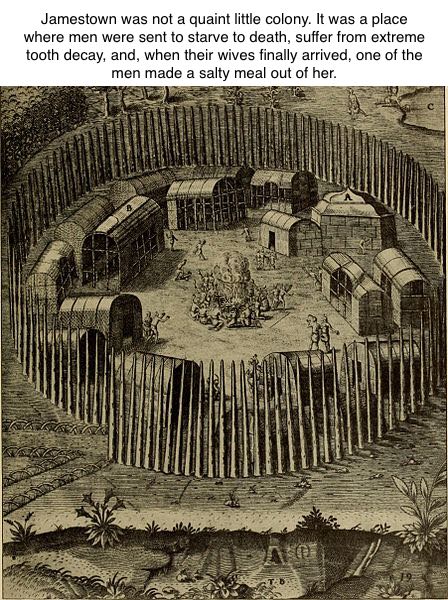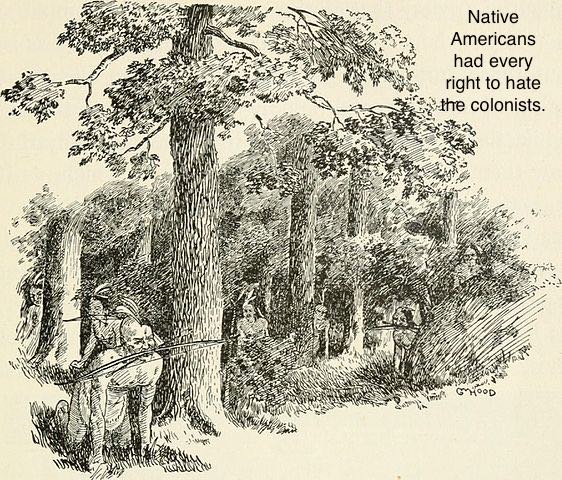
Staying alive in the New World was no easy task. In 1607, a group of about 104 people landed on the banks of the James River in Virginia to form what is now known as the Jamestown Colony. While the pristine land must have been a welcome sight after being at sea for the long trip from England, the truth was that they picked one of the worst places along the coast to settle down. These first permanent English settlers were ill prepared for the weather and the terrain of the New World. Unlike Roanoke, the “lost colony,” these new settlers were determined to do whatever it took to survive, even if it meant doing the unthinkable. [SOURCE 1]

Too Much Testosterone
The first batch of settlers to arrive in 1607 were all men. This makes sense if you consider that these very first people were expected to begin building the colony and laying out the foundation for more settlers to come. Without the distraction of women, these guys should have breezed through the project without any trouble, but their egos got in the way.
It did not take long before the men were at each other’s throats. Nearly every single man wanted to be the one in charge and the situation grew dangerous. They accused each other of hoarding food and there were talks of a rebellion. Inside of the first three months, one of the original councilors was hanged for mutiny.
It was a sketchy way to exist, but about a year later two women entered the colony and joined in the dangerous lifestyle of living on the literal edge. Another thirteen years passed before a decent group of unmarried women were brought over to hopefully smooth over the harsh realities of living in the New World. [SOURCE 2]
A Terrible Drought
As if a bunch of scared and angry men bickering amongst themselves was not enough, they also happened to land at the start of a seven year drought. The men did not bring enough food supplies with them to survive the harsh conditions of the worst drought to hit the area in 770 years. Instead, the men had brought non-perishable items that could be traded with the native tribes for food.
Because of the intensely dry conditions, food could not be grown in abundance. They had to rely on John Smith and a few other men to head out and either attempt to barter for food or steal corn from the native people’s land. [SOURCE 3]
Arsenic Water
Even though there was a drought, there was water. However, it was not the kind of water you would ever want to drink. After landing at what was to become Jamestown, the men dug wells for water. While this was necessary, it does not mean that the water was actually all that good. Quite the contrary in this case because recent testing has confirmed that the water the early colonists drank had pretty high levels of arsenic. There was also fecal matter in the water and high levels of salt. In other words, the water tasted terrible, smelled like sulfur, and probably contributed to the high mortality rates in the settlement.
There were rumors that the Spanish had poisoned the wells with arsenic as a way to get rid of the English settlers, but scientists now say that the arsenic occurred naturally. [SOURCE 7]

Take It All
The Virginia Company funded the colonists with very clear intentions. First and foremost, the colonists were supposed to seek out gold and silver to send back to England. They were also charged with finding a route to the Pacific.
Aside from prospecting, the men were supposed to gather tributes from the native tribes and seek out other natural resources that could be exploited by England.
Finding things that could be easily manufactured in the New World was high on the priority list. England wanted untapped resources and the profits that would come from new products. This included both wine and hemp.
Unfortunately for the native people, the colonists were charged with converting them to Christianity, as if that would make the theft of their natural resources somehow more palatable. [SOURCE 3]
Heavy Tooth Decay
No women, lack of food, and a severe drought were just some of the troubles these early colonists face. Tooth decay was another serious issue, as discovered by forensic experts examining the remains of the early colonists.
It is believed that these early settlers were accustomed to their barley and wheat diets back in England. When they made the move to the New World, poor nutrition and corn became major contributing factors to their tooth decay.
Corn that was stolen from the native people and later grown made tooth decay and abscesses more prevalent in the colonists who spent the most time living in the New World. Those who died relatively soon after reaching the New World had far less tooth decay than those who survived.
With no dentists or oral care, many of these men lived and died in terrible pain. [SOURCE 4]
Eat Thy Neighbor
Perhaps it was a good thing that so few women were in the colony in the early years because it was recently discovered that one very young woman was probably eaten.
The Smithsonian reported in 2013 that an excavation found the remains of cats, dogs, and horses that were butchered and eaten during the “starving times” from 1609 to 1610. They also discovered in the rubbish pit the remains of a 14-year-old English girl whose bones show evidence of cannibalism. The girl, it is believed, arrived in Jamestown in 1609 on a resupply ship.
While it is not known if she was murdered out of shear hunger or if she died of some other cause, her skull shows evidence that it was cracked open and her brain was removed. Her bones were cut up in the same manner as the animals that were eaten during this time, providing near definitive proof that the Jamestown colonists practiced cannibalism at least once in an effort to survive the severe drought and lack of food. [SOURCE 5]
A Salty Wife
While only recent evidence of cannibalism in Jamestown has been discovered, there were numerous written reports of people eating the dead during the “starving times.”
People were so desperate for something to eat that they were digging up the dead. They were also eating roots, seeds, snakes, and leather.
In one historical report, a man decided that the best way to pull through the rough times was to murder his pregnant wife. He salted her remains and managed to survive the hunger until his crime was discovered. He was tortured to confess and was then burned alive. [SOURCES 5, 6]
Unusual Use For Oyster Shells
Besides eating people and other undesirable things, the people of Jamestown grew more and more desperate to steal crops from the native people. In fact, their hunger made them rather brazen in the act of theft.
During the starving times, one man, Ratcliffe, was caught foraging for food in one of the Powhatan villages. Naturally, the Powhatan were sick and tired of having their food stolen and decided to make one heck of an example out of Ratcliffe. The man was executed by having his skin scraped off using oyster shells. [SOURCE 6]
Secret Catholics
One of the first things the settlers built in Jamestown was a fort. After that, they built a storehouse, their church, and surrounding buildings. The church was the first Protestant Church in the New World and was excavated in recent years by archaeologists.
Within the ruins of the church, archaeologists found four graves containing the skeletal remains of prominent men from the early Jamestown colony. While this find is not so unusual, the archaeologists were surprised to find a small silver box buried with Captain Gabriel Archer.
Upon further investigation of the silver box, researchers discovered a container used for holding holy relics of the Catholic Church. Records show that Archer’s Catholic parents were persecuted in England and that Archer may have secretly been a Catholic. Even more exciting, there may have been other secret Catholics living in Jamestown during the early years. [SOURCE 8]
The Odds Favored An Awful Death
Getting sent to the Jamestown was pretty much the same as getting a death sentence. Out of the first wave of approximately 104 men, there were only 38 men left alive by the end of nine months. There were approximately six thousand settlers who arrived in Jamestown between 1607 and 1625. Nearly five thousand of those settlers met untimely deaths.
The causes of these unfortunate deaths were numerous. There was, of course, starvation. The swamp waters surrounding the settlement were filled with mosquitoes and some historians believe that malaria wiped out large numbers of settles. Their fresh water was also poisonous and nearly undrinkable.. People were also attacked by the Powhatans and many died from festering wounds.
The early settlers of Jamestown lived uncertain lives. They lived in constant fear of outside attacks and they waited desperately until a new supply ship would arrive, never knowing if they would live to see another day. [SOURCES 4, 5]

